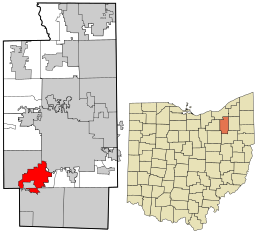Barberton, Ohio
| Barberton, Ohio | |
|---|---|
| City | |
| Nickname(s): The Magic City | |
 Location in Summit County and the state of Ohio. |
|
| Coordinates: 41°0′57″N 81°36′21″W / 41.01583°N 81.60583°WCoordinates: 41°0′57″N 81°36′21″W / 41.01583°N 81.60583°W | |
| Country | United States |
| State | Ohio |
| County | Summit |
| Government | |
| • Mayor | Willam Judge (D) |
| Area | |
| • Total | 9.26 sq mi (23.98 km2) |
| • Land | 9.04 sq mi (23.41 km2) |
| • Water | 0.22 sq mi (0.57 km2) |
| Elevation | 974 ft (297 m) |
| Population (2010) | |
| • Total | 26,550 |
| • Estimate (2012) | 26,316 |
| • Density | 2,936.9/sq mi (1,133.9/km2) |
| Time zone | Eastern (EST) (UTC-5) |
| • Summer (DST) | EDT (UTC-4) |
| ZIP code | 44203 |
| Area code(s) | 330 |
| FIPS code | 39-03828 |
| GNIS feature ID | 1037625 |
| Website | http://www.cityofbarberton.com |
Barberton is a city in Summit County, Ohio, United States. The population was 26,550 at the 2010 census. It is a commuter town adjacent to Akron and is part of the latter's Metropolitan Statistical Area.
Barberton was founded in 1891 by industrialist Ohio Columbus Barber, who planned the town according to his vision of industry, progress and community. In 1894 he moved the manufacturing operations of the Diamond Match Company, which he formed from a merger of 11 companies, from Akron to Barberton. He soon was producing 250 million matches a day. In the valley running parallel to the Tuscarawas River and the Ohio & Erie Canal, he oversaw the construction of factories, residential neighborhoods and a compact commercial downtown. In the center of the new city was Lake Anna, named after Barber's only daughter, Anna Laura Barber.
Barberton became known as the "Magic City" because of its rapid population growth during its formative industrial years, at a time of waves of immigration from eastern and southern Europe. In 1891, when Barberton was incorporated, the scattered farms that had originally characterized the landscape were transformed into a fledgling city of 1,800. When an Akron Beacon Journal reporter revisited Barberton in 1893, he noted that since 1891, it had grown so quickly that it appeared to have grown by magic (hence its nickname). Many new immigrants were attracted to its industrial jobs, which provided a path to assimilation.
In 1908 on a high hill on the east side of town, Barber began construction of an experimental farm and estate, which he called Anna Dean Farm. It included his 52-room, French Renaissance Revival-style mansion, completed in 1909, and lush gardens, dozens of barns and other structures in the same style, and greenhouses. Barber built 35 structures for the Anna Dean Farm, all in the French Renaissance Revival style. The farm covered 3500 acres. Believing farming could be as efficient as industry, Barber intended the farm to be the basis of an agricultural college, but he did not complete its financing before his death. He willed the farm to Case Western University. It later sold much of the property.
...
Wikipedia
